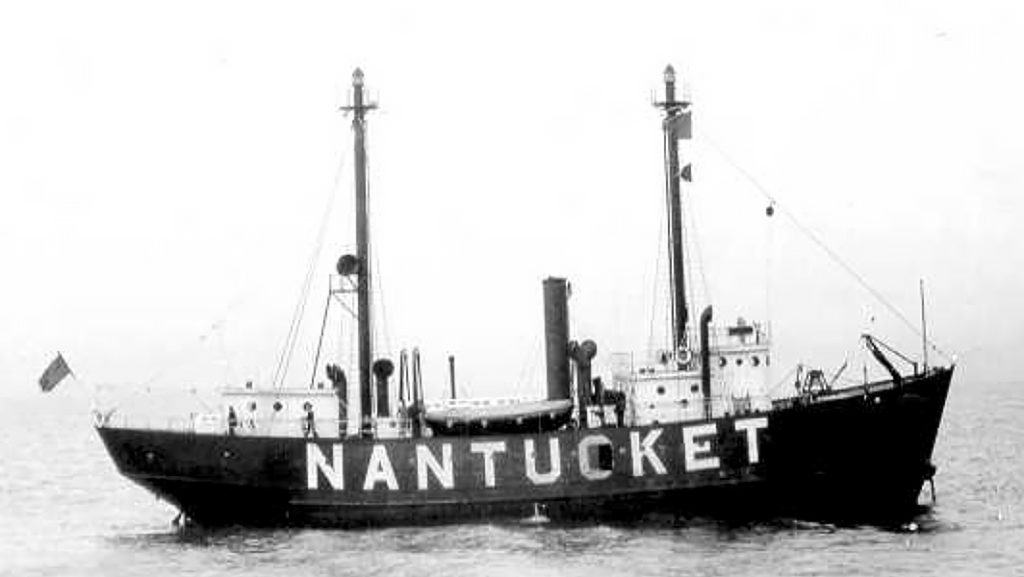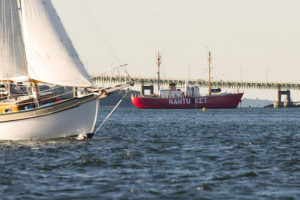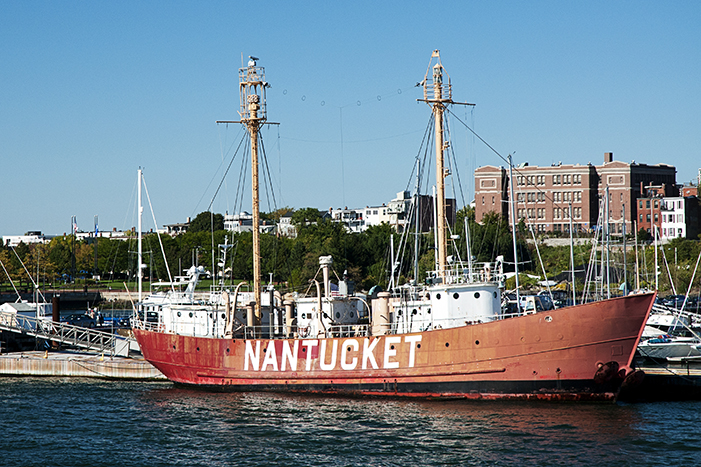
Lightship Nantucket Collision Sunk by RMS Olympic. Painting by artist Charles J. Mazoujian. Courtesy of Gwen Mazoujian and the US Coast Guard.
Tragedy Involving the Nantucket Lightship Collision with the RMS Olympic
Dangers of Living on a Lightship
Where lighthouses and light stations were built on specific locations as navigational guides, to aid mariners in distress, or assist mariners in inclement weather, lightships were needed in the late 1800s as mobile floating lighthouses at dangerous locations or within busy shipping channels where it was not possible to build a lighthouse. The crews of these relatively small vessels would endure extremely cramped and lonely conditions away from the mainland, along with extreme weather conditions in fog, violent storms, hurricane-force winds, swelling seas, and natural formations like ice floes that could rip the ship’s hull. If a storm approached and vessels were trying to seek safety in nearby harbors (or even in clear weather), lightships would remain at anchor at their designated stations during the storm and provide the flashing light or sound their fog horn to help each vessel navigate to safety. Working on a lightship was known as the most hazardous profession in the Naval marine service. New England had its share of accidents and tragedies. To make matters worse, the early lightships of the late 1800s and early 1900s were usually in deteriorating conditions from a lack of funding by the government.
Most Famous Lightship: the Nantucket Lightship LV-117
One of the worst tragedies in lightship history involved the Nantucket Lightship LV-117, but the lightship also had its share of close calls beforehand. The 130-foot Lightship LV-117 was built in 1930 and went into service in 1931. It carried the most modern signaling equipment of the time. It was stationed 50 miles southeast of Nantucket Island in the deep waters stationed in the middle of the trans-Atlantic shipping channel. It was considered the most exposed lightship on the East Coast, as it was out the furthest and subject to the unpredictable New England weather, heavy seas, and the constant fog that would encompass the region. Its position was needed as it lay near the Nantucket Shoals, an area where the depth of the ocean decreased dramatically and had claimed many ships and lives as vessels would run aground and would be wrecked by pounding waves. From its position, incoming ships could take bearings from its elite radio signal as far as 300 miles away. One night, during heavy fog on January 6, 1934, the Nantucket transmitted radio signals to the ocean liner SS Washington, the largest ocean-going ship ever built in the United States. The SS Washington’s lookout misjudged the coordinates, and the monstrous vessel sideswiped the Nantucket. The Nantucket returned to port for repairs, and the impending tragedy was averted.
Nantucket Lightship Collision with the RMS Olympic

RMS Olympic passed by Nantucket Lightship a few months earlier before the tragic collision. Image courtesy US Coast Guard.
Although it nearly escaped disaster a few months earlier, when the ocean liner RMS Olympic passed dangerously close to the Nantucket Lightship in January of 1934, it would become involved in one of the worst tragedies in lightship history with the Olympic. On May 15, 1934, when heavy fog had engulfed the region, the Nantucket lay anchored in 192 feet of water just south of Nantucket Shoals. That night, the lightship sounded her fog horn for the incoming 47,000-ton, 900-foot ocean liner, Olympic, the sister of the infamous Titanic and Britannic vessels. She was traveling at a speed of 20 knots. The RMS Olympic had sailed across the Atlantic for nearly 25 years with over 250 uneventful excursions. The Olympic had followed the Nantucket’s radio beacon signal to alter her course when she was close enough to the lightship. The lookout on the Olympic had miscalculated the Nantucket’s location and could not see the lightship in the fog until she was a mere 500 feet from colliding with the doomed vessel. The crewmen of the Nantucket sounded the alarm for the impending collision and grabbed their life preservers as the Olympic approached them. The Olympic was nearly 75 times the size of the Nantucket and literally ran over the lightship on its broadside, cutting it in half. The Captain of the Olympic ordered boats put over to save the crew, but the Nantucket sank within minutes. Seven of the eleven lightship crewmen drowned in the frigid waters, and four were rescued, including Captain George Braithwaite. Captain Braithwaite died a few months later from his injuries.
The New Rebuilt Nantucket Lightship
The owners of the Olympic, the White Star Line from Britain, built a new lightship for the Coast Guard as part of an agreed-upon compensation to replace the Nantucket and in remembrance of those who perished that night in 1936. It was named the Nantucket Lightship LV-112. It looked like a miniature version of a battleship with a more robust hull and 43 watertight compartments to keep it afloat should an impending disaster strike. It was built so that whenever the fog horn would sound, the radio transmitter would broadcast a signal at the same instance so that navigators from oncoming vessels could quickly calculate the distance to the lightship. The new Nantucket lightship served on the Nantucket Shoals, near Nantucket Island, from 1936 to 1942; she was painted grey and used as an examination vessel during World War II at the entrance to Portland Harbor. After the war, she was repainted red and returned to duty on Nantucket Shoals. In 1960, the Nantucket LV-112 underwent significant renovations, making it the largest lightship ever built. In those years, she and her crew survived two major hurricanes in 1954 and 1959, where she lost anchor, was smashed up, and drifted many miles away from her station. The Nantucket became the longest-serving lightship on its Nantucket Station as she was decommissioned in 1975.
The lightship era ended in 1985, with many lightships gradually deteriorating. Many non-profit volunteer organizations stepped up to save those lightships remaining. Most have become floating museums as a testament to the courage and bravery of its crews stationed in the most hazardous conditions. Today, there are believed to be only 15 lightships in existence. The Nantucket LV-112 became the last to be decommissioned and, as other lightships, fell into disrepair. With the necessary funding provided over the years, the Nantucket LV 112 now remains as the floating United States Lightship Museum. It has been docked in East Boston at the East Boston Shipyard and Marina since 2009. She is a proud testament to the men who served in the most perilous Naval position.
Artist Charles J. Mazoujian
The image at the top is a famous painting created of the incident by artist Charles J. Mazoujian. The best visual of the tragedy of the Natucket Lightship collision with the RMS Olympic is best exemplified by this artist. He was educated at the Pratt Institute and created comic book art on features for Fiction House (“Captain Terry Thunder”), and Novelty and Quality Comics. he was involved with creating covers for Marvel Mystery Comics. In the early 1940s, he provided art on the ‘Lady Luck’ Sunday page for the Register and Tribune Syndicate.
After World War II, Mazoujian returned to New York to teach painting and figure drawing at the Pratt Institute night school. He also was involved in freelance book illustrations and commissioned paintings, like the one shown here. During the 1960s, he worked for Oglivy & Mather Advertising. He was a longtime member of the Society of Illustrators in NY and actively participated in the US Air Force Art program. In January 2011, Charles Mazoujian passed away in Sacramento, California. Thank you for your brilliant work.
Exploring the Lightship Museum in Boston
If you are interested in visiting this remarkable floating museum:
Mailing Address:
United States Lightship Museum
(Nantucket Lightship LV-112)
Post Office Box 454
Amesbury, MA 01913-0010
Phone: (617) 797-0135 FAX 1 (603) 394-0285
rmmjr2@comcast.net
Address to Visit the Lightship Museum:
Boston Harbor Shipyard and Marina
256 Marginal Street
East Boston, MA 02128
http://www.nantucketlightshiplv-112.org/
Enjoy!
Allan Wood
The Rise and Demise of the Largest Sailing Ships: Stories of the Six and Seven-Masted Coal Schooners of New England. In the early 1900s, New England shipbuilders constructed the world’s largest sailing ships amid social and political reforms. These giants were the ten original six-masted coal schooners and one colossal seven-masted vessel, built to carry massive quantities of coal and building supplies and measured longer than a football field! This book, balanced with plenty of color and vintage images, showcases the historical accounts that followed these mighty ships.
Available in paperback, hardcover, and as an eBook for all devices.

Book – Lighthouses and Coastal Attractions in Southern New England: Connecticut, Rhode Island, Massachusetts
My 300-page book, Lighthouses and Coastal Attractions of Southern New England: Connecticut, Rhode Island, and Massachusetts, provides special human interest stories from each of the 92 lighthouses, like the one about the Nantucket lightship collision mentioned above, along with plenty of indoor and outdoor coastal attractions you can explore. These include whale-watching excursions, lighthouse tours, windjammer sailing tours, adventures, unique parks and museums, and even lighthouses where you can stay overnight. You’ll also find plenty of stories of shipwrecks and rescues. Lighthouses and their nearby attractions are divided into regions for weekly and weekend explorers. You’ll also find plenty of stories of hauntings around lighthouses.
My 300-page book, Lighthouses and Coastal Attractions of Northern New England: New Hampshire, Maine, and Vermont provides memorable human interest stories from each of the 76 lighthouses, along with plenty of indoor and outdoor coastal attractions you can explore and tours. Lighthouses and their nearby attractions are divided into regions for weekly and weekend explorers. Attractions and tours also include whale watching tours, lighthouse tours, windjammer sailing tours and adventures, special parks and museums, and lighthouses where you can stay overnight. There are also stories of haunted lighthouses in these regions.
Included are more details of the story of the collision between the Nantucket Lightship and the RMS Olympic ocean liner, along with over 50 other stories in my book New England Lighthouses: Famous Shipwrecks, Rescues & Other Tales. This image-rich book also contains vintage images provided by the Coast Guard and various organizations and paintings by six famous artists of the Coast Guard.
You’ll find this book and the lighthouse tourism books from the publisher Schiffer Books or in many fine bookstores like Barnes and Noble.
Copyright © Allan Wood Photography; do not reproduce without permission. All rights reserved.
Join, Learn, and Support The American Lighthouse Foundation








